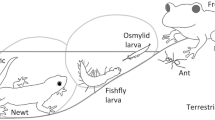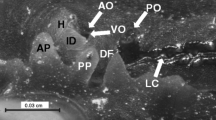Abstract
Gyrinid beetles are common in ponds and lakes in Sweden, where they aggregate in open areas of the surface. Gyrinid beetles have pygidial glands which produce compounds rendering them unpalatable to fish. This study examines whether the pygidial secretion can be used for alarm purposes in addition to other functions. Experiments showed that gyrinid beetles responded to water prepared with the pygidial compounds by evasive behaviour. The beetles did not respond when the compound was mediated by air. One component of the defense system of gyrinids is how they advertise their presence. The aggregation of dark beetles with their typical motion pattern when alerted is very conspicuous and easily identified by an experienced predator. We suggest that this aspect of gyrinid defence can be characterized as aposematic.
Similar content being viewed by others
References
Alexander RD (1974) The evolution of social behavior. Annu Rev Ecol Syst 5: 325–387
Benfield EF (1972) A defensive secretion of Dineutes discolor (Coleoptera: Gyridinae). Ann Entomol Soc Am 65: 1324–1327
Brönmark C, Malmqvist B, Otto C (1984) Anti-predator adaptations in a neustonic insect. Oecologia 61: 189–191
Dettner K (1985) Ecological and phylogenetic significance of defensive compounds from pygidial glands of Hydradephaga (Coleoptera). Proc Acad Nat Sci Phil 137: 156–171
Edmunds M (1974) Prefence in animals: A survey of anti-predator defences. Longman, Harlow, Essex
Fitzgerald VJ (1987) Social behavior of adult whirligig beetles Dineutes nigrior and D. discolor (Coleoptera: Gyrinidae). Am Midl Nat 118: 439–448
Forsyth DJ (1968) The structure of the defensive glands in the Dytiscidae, Noteridae, Haliplidae and Gyrinidae (Coleoptera). Trans R Entomol Soc London 120: 159–182
Foster WA, Treherne JE (1981) Evidence for the dilution effect in the selfish herd from fish predation on a marine insect. Nature 293: 466–467
Guilford T (1986) How do warning colours work: Conspicuousness may reduce recognition errors in experienced predators. Anim Behav 34: 286–288
Guilford T (1990) The evolution of aposematism. In: Evans DL, Schmidt JO (eds) Insect defenses: adaptive mechanisms and strategies of prey and predators. State University of New York Press, Albany, pp 23–61
Hamilton WD (1971) Geometry for the selfish herd. J Theor Biol 31: 295–311
Hamilton WD (1972) Altruism and related phenomena, mainly in social insects. Annu Rev Ecol Syst 3: 193–232
Heinrich B, Vogt FD (1980) Aggregation and foraging behaviour of whirligig beetles (Gyrinidae). Behav Ecol Sociobiol 7: 179–186
Henrikson B-I (1988) The absence of antipredator behaviour in the larva of Leucorrhinia dubia (Odonata) and the consequences for their distribution. Oikos 51: 179–183
Humphries DA, Driver PM (1970) Protean defence by prey animals. Oecologia 5: 285–302
Meinwald JK, Opheim K, Eisner T (1972) Gyridinal: a sesquiterpenoid aldehyd for the defensive glands of Gyrinid beetles. Proc Natl Acad Sci USA 69: 1208–1210
Miller JR, Mumma RO (1976) Physiological activity of water beetle defensive agents. I. Toxicity and anesthetic activity of steroids and norsesquiterpenes administrated in solution to the minnow. J Chem Ecol 2: 115–130
Nault LR, Phelan PL (1984) Alarm pheromones and sociality in presocial insects. In: Bell WJ, Cardé RT (eds) Chemical ecology of insects. Chapman and Hall, London, pp 237–256
Newhouse NJ, Aiken RB (1986) Protean behaviour of a neustonic insect: factors releasing the fright reaction of whirligig beetles (Coleoptera: Gyrinidae). Can J Zool 64: 722–726
Scrimshaw S, Kerfoot WC (1987) Chemical defenses of freshwater organisms: beetles and bugs. In: Kerfoot WC, Sih A (eds) Predation — direct and indirect impacts on aquatic communities. University Press of New England, Hanover London, pp 240–262
Stenson JAE (1979) Predator-prey relations between fish and invertebrate prey in some forest lakes. Rep Inst Freshwater Res Drottningholm 59: 166–182
Treherne JE, Foster WA (1981) Group transmission of predator avoidance behaviour in a marine insect: The Trafalgar effect. Anim Behav 29: 911–917
Tucker VA (1969) Wave-making by whirligig beetles (Gyrinidae). Science 166: 897–899
Vulinec K, Miller MC (1989) Aggregation and predator avoidance in whirligig beetles (Coleoptera: Gyrinidae). J New York Entomol Soc 97: 438–477
Wiener LF, Capinera JL (1979) Greenbug response to alarm pheromone analog: temperature and humidity effects, disruptive potential and analog releaser efficacy. Ann Entomol Soc Am 72: 369–371
Wilson EO (1971) The insect societies. Harvard University Press, Cambridge, pp 120–135
Wohlers P (1981) Effect of the alarm pheromone (E)-betafarnesene on dispersal behaviour of the pea aphid Acyrthosiphon pisum. Ent Exp Appl 29: 117–124
Author information
Authors and Affiliations
Rights and permissions
About this article
Cite this article
Henrikson, BI., Stenson, J.A.E. Alarm substance in Gyrinus aeratus (Coleoptera, Gyrinidae). Oecologia 93, 191–194 (1993). https://doi.org/10.1007/BF00317670
Received:
Accepted:
Issue Date:
DOI: https://doi.org/10.1007/BF00317670




